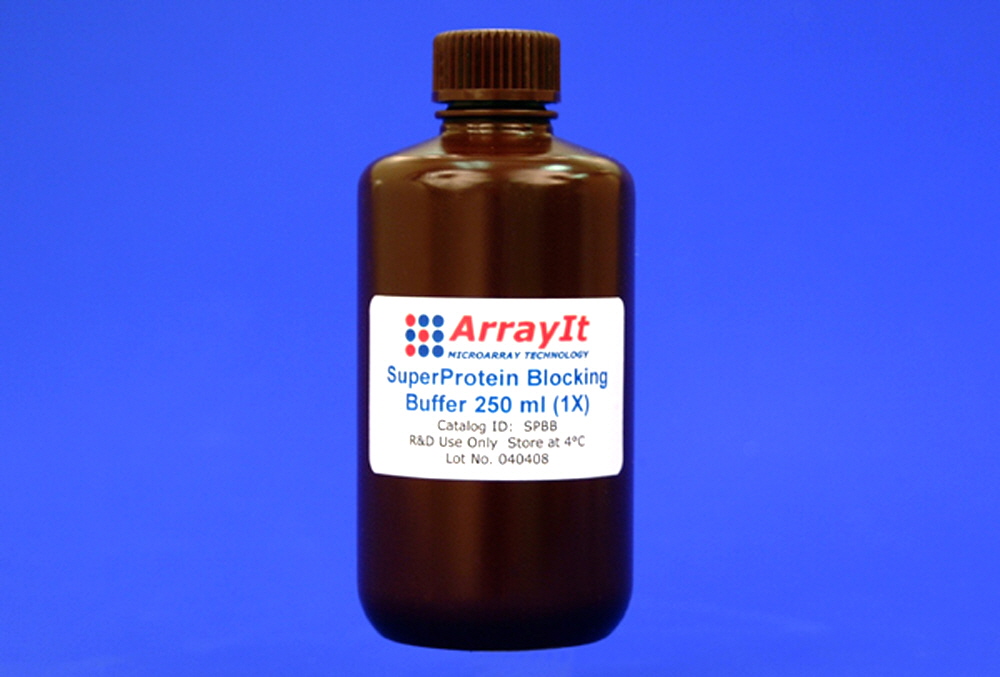SuperProtein Blocking Buffer
Data Sheet
![]() Shop this product in our online store
Shop this product in our online store
Products - Buffers & Solutions - Blocking Solutions - SuperProtein Blocking Buffer to Enhance Signal Strength and Reduce Non-Specific Binding on Nitrocellulose Microarrays

Designed to block SuperProtein, SuperPVDF, SuperNitro membrane based microarray surface chemistry prior to protein binding reactions for ultra low colorimetric background. For glass based protein microarrays use BlockIt. For assays sensitive to low amounts of detergent use SuperProtein Blocking Buffer.
Table of Contents
- Introduction
- Quality Control
- Product Description
- Technical Assistance
- Short Protocol
- Complete Protocol
- Troubleshooting Tips
- Recommended Requirements
- Ordering Information
- Warranty
Introduction
Congratulations on taking a big step towards improving the economies of scale, quality and speed of your proteomics research. This booklet contains a complete set of protocols outlining the steps and principles needed to use the Arrayit brand blocking buffer for membrane based surface chemistry. This product is design for use prior to incubation and hybridization reactions involving protein and DNA microarrays.
Quality Control
Arrayit assures the performance of these products, the finest scientific research went into their development. Store at 4 Degrees Celsius, the product has a 1-year shelf life when handled and stored properly.
Product Description
The buffer is designed for blocking the portions of microarrays that can bind proteins after printing to eliminate background following the incubation or hybridization reaction of protein microarrays. Users will appreciate the following features:
- Ultra-pure reagents used for buffer formulation
- Purified by sterile filtration
- Provided as 1X ready to use concentrate
- Recommended for use on SuperProtein Substrates, but compatible with other protein membrane based microarray surface chemistries
- Easy coverslip blocking procedure
- 250 ml volume provided efficiently blocks thousands of microarrays
- Will not react with proteins and DNA
Technical Assistance
Please contact us if you have any comments, suggestions, or if you need technical assistance. By electronic mail: arrayit@arrayit.com (under the subject heading, please type Arrayit technical assistance). Please remember that we want to hear about your successes!
Short Protocol for Protein Microarrays
Wash microarray with PBS and then incubate microarray in 1X blocking buffer under a coverslip for 1 hour prior to protein binding reactions.
Complete Protocol for Protein Microarrays
Protein binding to our membrane surfaces is stable and the microarrays can be washed, blocked and reacted without sufficient loss of coupled protein. Block the printed microarray surface using a 1-hour incubation at room temperature in 1X SuperProtein Blocking buffer. Perform this reaction under a coverslip using 4 ul of buffer for every cm2 of coverslip area. Once the printing process is complete, wash the printed microarrays 2 times for 15 minutes each in a High Throughput Wash Station in 1X PBS to remove unbound protein molecules and buffer components from the SuperProtein Substrates.A Hybridization Cassette can be used to keep the blocking reaction from drying out. SuperProtein blocking buffer will couple to un-reacted binding sites of the surface and prevent unspecific binding and background. After blocking, wash the microarrays to remove excess buffer. Washing three times for 1 min each at room temperature with 1X PBS in a High Throughput Wash Station. DO NOT USE DETERGENT BASED buffers on the SuperProtein nor SuperPVDF, low concentrations are compatible with SuperNitro.
Troubleshooting Tips
If microarray shows high background:
- Confirm that the intrinsic background of the microarray is low to start with.
- Be sure to not let any sample dry on the microarray surface during the binding reaction.
- Make sure to purify away unincorporated components of any labeling reactions.
- Take care to block for the recommended time (1 hour).
- Pay attention to the proper handling and shelf life of the buffer (1 year shelf life, Store at 4 C).
- Do not skip washing the microarray after the blocking step.
- If colorimetric labeling was used, be sure to optimize development times
Recommended Requirements

